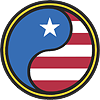Traditional Chinese Medicine Theories
Yin and Yang
The yin and yang theory is an essential part of Traditional Chinese Medicine (TCM) in both the diagnosis and treatment of diseases and the understanding of all things on earth.
The yin and yang theory explains all things in the universe. Some examples of yang are: male, bright, active, external and hot. A few yin examples are: female, dark, static, internal and cold. Yin and yang do not exist without the other; they both oppose and complement each other. These forces are never absolute, in that yang is never all yang and yin is never all yin. A yang object always contains some amount of yin and vice versa. These forces are balanced in the body and the universe.
In TCM yin and yang play an important role in your health. The theory is used to explain pathological changes in the body. For example, the onset of a fever can be described as an excess of yang or a deficiency of yin that leads to a hot condition. Acupuncture and TCM restores the natural balance between these two forces to help you recover from illness. Yin and yang is also used to explain the structure of the human body, for example: internal, external; upper, lower; lateral, medial. When these forces are out of balance, disease and symptoms will arise. Acupuncture and other modalities of TCM help to restore balance to yin and yang thus improving your health.
Qi
Qi (pronounced “chi”) is the energy that flows throughout our body in a system of pathways called meridians. Qi has the important task of promoting bodily functions, warming the body, defending the body from external factors and nourishing the whole body. The free flow of Qi is what keeps us healthy. When the flow of this energy is disrupted, Qi becomes stagnated and causes disease.
Blood
Blood, also called xue, is a fundamental substance in the body. The function of blood is to moisten and nourish the various organs and tissues in the body. It also serves as a key element in the development of bones, muscles, organs, nerves, and skin. If blood is insufficient, numbness, dryness, itchiness and impairment of the normal function of joints may be affected. Blood is an important element in the development and maintenance of good mental activity. Having a sufficient blood supply ensures a clear conscious and vibrant spirit.
Body Fluids
Jin ye, or body fluids, is a term used to describe all of the normally occurring fluids in the body. These fluids include: saliva, tears, nasal discharge, sweat, urine, gastric and intestinal juices and liquids within the joint cavities. These fluids are divided into clear and thin fluids, jin, and thick and heavy fluids, ye. Jin fluids have the function of moistening the skin and warming and nourishing the muscles. Ye fluids nourish the internal organs, bones and body orifices as well as moistening the joints.
Body fluids have a codependent relationship with both Qi and blood. Body fluids are reliant on the circulation of Qi to be formed, distributed throughout the body, and excreted. An accumulation of these body fluids may hinder the circulation of Qi. Body fluids and blood are important to one another because they can be transformed into each other.
Jing
Jing, or essence, is a vital substance important in the functions of growth, reproduction and aging. Your essence is formed from your parents energy and the energy that you consume (air, food, water). Essence is essential in the development of bones, muscles, hair, teeth and the brain in children. Essence is responsible for developing and maintaining the reproductive functions of our bodies. A decline in essence is what starts the aging process after we have reached our peak development. It is believed that together, jing and Qi create our shen, or spirit.
